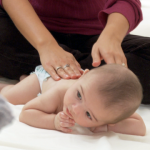Baby Massage Instruction
My last article discussed some of the many benefits of baby massage and how practitioners could use it to improve functional skills in babies, educate parents, and enhance our overall practice. In this article I provide an overview of some baby massage strokes. I would like to reiterate the importance of demonstrating the massage technique for parents and caregivers as opposed to performing the massage. The benefits of bonding and relaxing the caregiver along with the baby are only reaped when the massage is performed by the caregiver. Remember the occupational therapy mantra: Give a person a fish and they eat for a day, teach a person to fish and they eat for a lifetime. This is so true in the case of baby massage.
Getting Started
To begin the massage, simply review some of the benefits with the caregiver. Make sure they have clean hands and a warm blanket to wrap the baby in.
The baby should be wearing only a diaper. The baby should be either on the caregiver’s lap or lying in front of the caregiver on the sofa, bed or floor. Show respect by making eye contact and asking the baby if he is ready for his massage. You can use a little bit of baby lotion, but I do not recommend oil. Each of the strokes should be repeated about 4-5 times.
Opening Stretch
Instruct caregiver to slide their hands under the baby’s hips. Make a motion as if telling someone to “come here”, rolling fingers up toward the baby’s hips, lifting his hips about two inches. This opens the lower back and pelvis.
Leg Strokes
Remove one of the baby’s legs from the blanket. Hold baby’s foot by wrapping index finger around his ankle while pressing thumb into the sole of his foot. This uses a little bit of reflexology to calm him. Use the entire hand to make a circle around the baby’s upper leg. Use a gentle back and forth wringing motion to massage from upper leg toward ankle. Repeat this on other leg.
Watch this video to see examples of these strokes:
Abdominal Reflex Stroke
This stroke triggers a reflex to move the bowels and it is very effective. Perform this stroke on the baby’s bare belly. Use the tip of the index finger to make a very light, ticklish, spiraling motion from the belly button to the outer edges of the belly. Move very quickly in a clockwise direction.
I Love You Stroke
This stroke also moves the bowels by tracing the large intestine in the shape of the letters I, L and U. Gently press two fingers into the baby’s belly just to the right of the belly button and draw a capital I top to bottom, and then drag fingers across top of belly button, then down the side to make a sideways L. Finally, lift the hand and start on the bottom left side of the belly button and draw an upside down U up and over the belly button.
Chest Strokes
Place two hands on baby’s chest, then stroke down from shoulders toward hips with one hand, then the other. The chest is highly sensitive. If the baby pulls away or arches her back, slow down or lighten the pressure.
Arm Strokes
Remove one arm from the blanket. Hold the baby’s palm with one hand while using the other hand to stroke from shoulder toward wrist with the same gentle wringing motion used on the legs, while rocking hand back and forth. Repeat on the other arm.
Now, baby can be gently rolled onto their belly.
Back strokes
Place both hands on baby’s back and stroke from shoulders to buttocks with one hand, then the other. Repeat several times. Next, with two fingers, make tiny circles beside baby’s spine from neck to tailbone. Repeat on the other side of her spine.
Perform these strokes several times to take advantage of tummy time.
Gently roll baby onto back.
Face and Head Strokes
Do not use any lotion on the baby’s face or head. Stroke from forehead, down cheek to chin, on one side then the other. Next, use index finger to stroke from the bridge of the baby’s nose, under her eye and up around her ear. Repeat several times on both sides of her face. Next make tiny circles all over baby’s scalp with fingertips, being careful of fontanels. Lastly use the tip of the finger to make clockwise circles right on baby’s lips. This will most likely elicit a tongue thrust and the baby will want to eat after the massage.
For some gentle baby stretches to enhance the massage and keep baby’s joints and muscles flexible and symmetrical, watch this video clip:
While this is a comprehensive overview of newborn massage, there are many more strokes that can be added for older babies. What strokes or techniques have you found to be most beneficial in your practice?
 Aimee Ketchum is a pediatric occupational therapist, licensed baby massage instructor, yoga instructor, and mom. She is also the founder of Aimee’s Babies, LLC, a baby and child development company. Please visit Aimee’s website www.aimeesbabies.com where you can find baby massage and developmental exercise DVDs, downloadable videos and apps. Aimee lives with her husband and two daughters in Lititz, Pennsylvania. You can email her at aimeek@ptd.net, She’d love to hear from you!
Aimee Ketchum is a pediatric occupational therapist, licensed baby massage instructor, yoga instructor, and mom. She is also the founder of Aimee’s Babies, LLC, a baby and child development company. Please visit Aimee’s website www.aimeesbabies.com where you can find baby massage and developmental exercise DVDs, downloadable videos and apps. Aimee lives with her husband and two daughters in Lititz, Pennsylvania. You can email her at aimeek@ptd.net, She’d love to hear from you!


